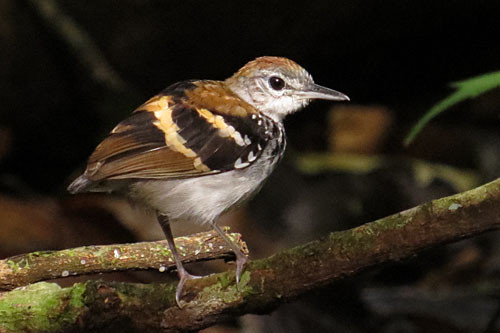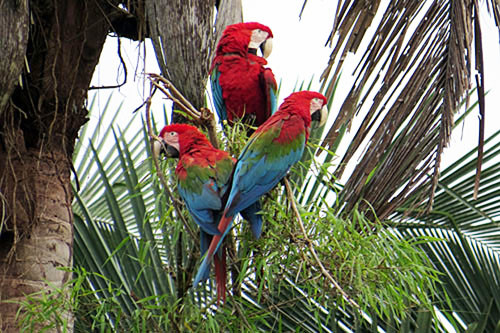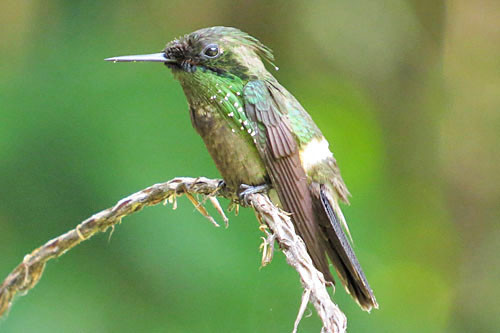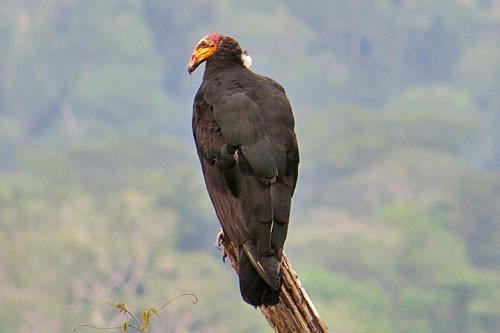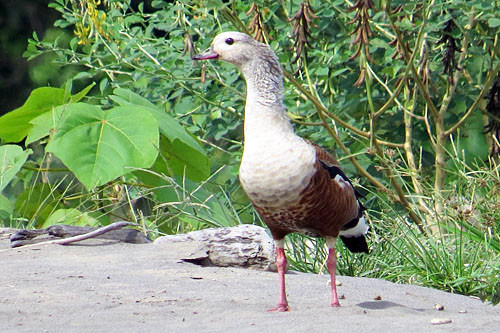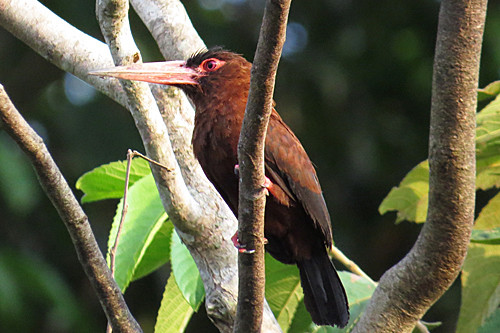 Purus Jacamar is a local Amazonian Peru resident partial to oxbow lakes. Photo: Rich Hoyer
Purus Jacamar is a local Amazonian Peru resident partial to oxbow lakes. Photo: Rich Hoyer The rainforests of southeastern Peru have long been known as the most species-rich in the world. Starting in the mountainous regions of Cusco and Puno, several rivers drain off the Andes into the river called Madre de Dios—Mother of God—before joining waters flowing northeast out of Bolivia and eventually making their way down to the Amazon River.
On their way to the Amazon, these rivers pass through Manu National Park and the Los Amigos Conservation Concession, huge areas of protected forest that abut even larger areas of wild, if at present unprotected, land. We’ll visit two lodges in this watershed, both on the Madre de Dios itself. We’ll cover an amazing variety of habitats, from open riverbanks to closed oxbow lakes and from seasonally flooded forest to tall upland forest well above the rivers. We’ll also sample the area’s high concentration of bamboo-dominated forest, which has a whole host of its own specialists. Topping off the list will be visits to a dirt bank used by hundreds of parrots and macaws each morning as well as a canopy platform to see the world from a unique angle. Besides birds, we’ll have a chance to look for several exciting mammals, such as Giant Otter, while also taking time to observe the myriad reptiles, amphibians, butterflies, and other invertebrates, enriching the entire natural history experience.
This tour can be taken with our tour Peru: Machu Picchu and the Manu-Kosñipata Road.
Day 1: The trip begins at 6 p.m. in the lobby of our Puerto Maldonado hotel. Night in Puerto Maldonado.
Rich is not only an excellent leader who does his best to get everyone on the birds and make sure that everyone’s personal needs are met, but he is without question the most knowledgable leader I have ever done a tour with. His knowledge of not only birds, but mammals, insects, flowers, reptiles, and just about every aspect of nature on the tour was awesome.
Alan Bromberg, Oct 2019
Day 2: Much of today will be devoted to travel as we drive to the port of Laberinto where we’ll board a covered and motorized dugout canoe for a five-hour journey to our home for the next few days, Los Amigos Research Station. The boat ride itself is delightful, and we’ll want to pause the journey for a few birds here and there. We’ll try to fit in some birding in the late afternoon as we familiarize ourselves with the grounds, perhaps seeing the Undulated Tinamous that, quite incredibly, forage in the open lawn. Night at Los Amigos.
Days 3–7: Los Amigos Research Station and Birding Lodge, owned by the nonprofit Amazon Conservation Association (which also owns Wayqecha and Villa Carmen Biological Stations, visited on the previous tour), is situated where the Los Amigos and Madre de Dios Rivers converge. The biological station is part of a watershed that includes millions of acres of protected wilderness in southeastern Peru. The landscape is a mosaic of terrestrial and aquatic habitats, including palm swamps, bamboo thickets, oxbow lakes, and various types of flooded and unflooded forests. Large stands of Guadua bamboo coupled with the extensive várzea (a wet forest inundated during the peak of the rainy season), terra firme (a forest occurring on higher ground that never gets flooded), and mature transitional floodplain forest ensure a huge variety of birdlife at Los Amigos. A casual day of birding on foot could easily yield 200 species. Two recent big days here tallied 345 and 347 species on foot, making this possibly the single birdiest location on the planet.
Some of the more interesting and unusual species possible in the bamboo are Rufous-headed Woodpecker, Manu Antbird, Peruvian Recurvebill, and Long-crested Pygmy-Tyrant. Throughout the forest various species of foliage-gleaners and antbirds join in mixed flocks. Some of the scarcer species here include Bartlett’s Tinamou, Razor-billed Curassow, Pale-winged Trumpeter, Pavonine Quetzal, Purus Jacamar, Cream-colored Woodpecker, Banded Antbird, Royal Flycatcher, and Musician Wren, to name but a few, and we’ll certainly look for the especially rare and local Rufous-fronted Antthrush and Black-faced Cotinga.
Butterflies abound here, and since the dragonflies of this region have been studied more thoroughly than almost anywhere else in the Amazon, we might be able to put names to some of the more colorful ones we see. Thirteen species of primates are known from the reserve, and we’ll surely see a good selection of some of them, and possibly even rarer mammals such as Jaguar, Giant Anteater, and Short-eared Dog.
Day 8: Today will be a travel day: we’ll motor up the Madre de Dios River to our next lodge, Tambo Blanquillo. Along the way we’ll stop for any number of birds that can be seen along the rivers, such as Sand-colored Nighthawk, roosting Great Potoo, Orinoco Goose, Capped Heron, and various other herons and parrots. Night at Tambo Blanquillo Lodge.
Days 9 - 10: During our two full days at Tambo Blanquillo, we’ll have several activities such as a boat ride on an oxbow lake, a visit to a parrot clay lick, and a visit to the canopy platform. An early morning visit to the clay lick should yield numbers of Yellow-crowned, Orange-cheeked, and Blue-headed Parrots, Chestnut-fronted Macaw, and most mornings groups of Red-and-green Macaws come down, though every day is different and unpredictable. Late morning will see us on the canopy platform where one has a totally novel view of the tropical rainforest. Here we’ll have a better chance to see species such as Gilded Barbet, Amazonian Pygmy-Owl, Purple-throated Fruitcrow, White-necked Puffbird, and Paradise, Turquoise, and Green-and-gold Tanagers. Finally, in the afternoon, we’ll take a two-hour boat ride on the lake, where we’ll look for Hoatzin, Sungrebe, Horned Screamer, American Pygmy and Green-and-rufous Kingfishers, and Pale-eyed Blackbird. With luck, we may see the rare Agami Heron and possibly spot a rail or two while looking for the local family of Giant Otters. Night at Tambo Blanquillo.
Day 11: After some early morning birding around our lodge, we’ll travel back to Puerto Maldonado via a combination of boats and wheeled vehicles, taking up much of the day, including stops for any birds and mammals. Night in Puerto Maldonado.
Day 12: We’ll have a few hours in the morning for some roadside birding near Puerto Maldonado, where we’ll certainly see a few new species. Rusty-margined Flycatcher occurs at the edge of its range here, and several species have spread into Peru from Bolivia in this area including Grassland Sparrow. On one recent tour, we discovered the second country record of White-bellied Seedeater, and on another, a Tiny Hawk was a wonderful surprise. You never know what you’ll see. We’ll have an afternoon flight back to Lima, and after a farewell dinner at the airport area hotel, the tour will conclude at the Lima International Airport.
Updated: 28 December 2022
Prices
- 2024 Tour Price : $5,350
- Single Occupancy Supplement : $790
Notes

Questions? Tour Manager: Greg Greene. Call 1-866-547-9868 (US or Canada) or (01) 520-320-9868 or click here to email.
* Tour invoices paid by check carry a 4% discount. Details here.
Maximum group size eight with one WINGS leader

